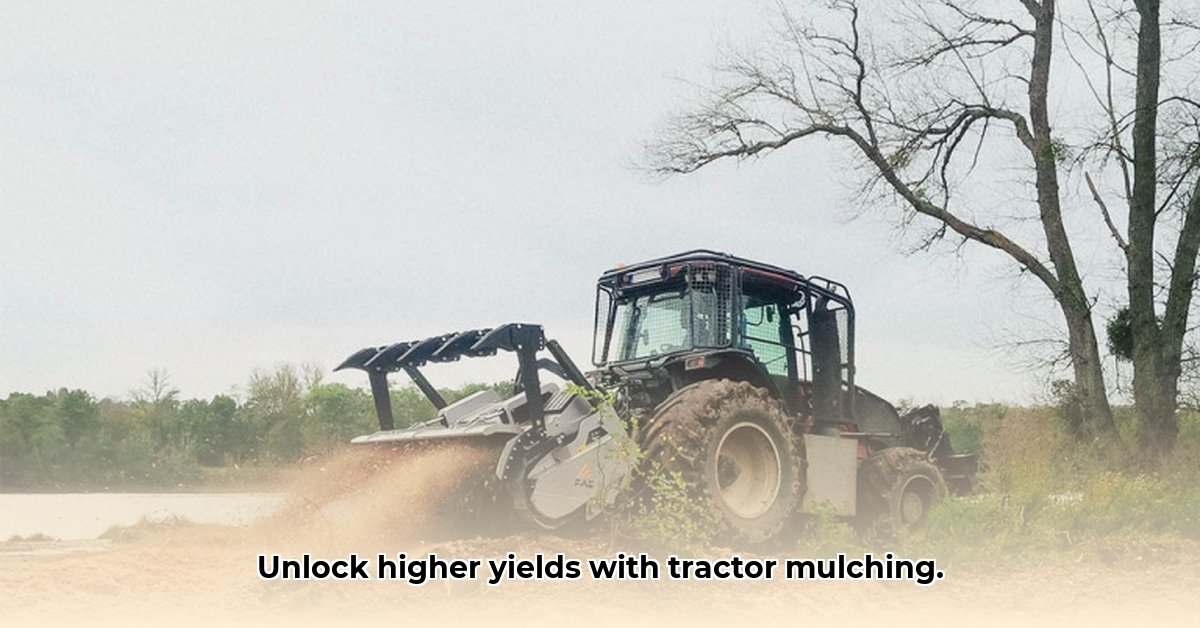
Mulcher for a Tractor: Boosting Your Yields with Sustainable Practices
Choosing the right tractor mulcher significantly impacts farm efficiency and sustainability. This guide provides actionable steps to select, operate, and maintain a mulcher, maximizing your return on investment (ROI) while promoting environmentally friendly farming practices. For more information on sustainable farming practices, check out this helpful resource on tractor supply and hay.
Matching Your Tractor Mulcher to Your Specific Needs
The success of your mulching operation depends on selecting a mulcher that's compatible with your tractor and land. Here's how to find the perfect fit:
1. Tractor Horsepower: Ensure your tractor has sufficient horsepower to operate the mulcher efficiently. Underpowering leads to inefficient operation and potential damage. Always check the manufacturer's specifications for recommended horsepower ranges. (Example: A 100-horsepower tractor might be suitable for a medium-duty mulcher, but a heavy-duty model might require 150 horsepower or more).
2. Vegetation Type: Different vegetation types require different mulcher designs. Heavy-duty mulchers with robust blades are needed for thick brush and small trees, while lighter models work better for grass and small shrubs. (Consider the diameter and density of the vegetation you'll be mulching).
3. Soil Conditions: Soil type affects mulcher selection and operation. Rocky or hard soil necessitates a rugged mulcher designed to withstand impact and debris. (For example, a mulcher with hardened steel components would be ideal in rocky conditions).
4. Desired Mulch Size: The size of the mulch produced impacts soil health and subsequent farming practices. Fine mulch is excellent for seedbeds; coarser mulch is better for erosion control. (Think about your post-mulching plans: seedbed preparation or erosion management).
5. Budget and Return on Investment (ROI): Factor in purchase price, maintenance costs, and the potential increase in yields and labor savings to calculate your ROI. (A detailed cost-benefit analysis can help determine the long-term economic viability of the mulcher).
Operating and Maintaining Your Tractor Mulcher: A Guide to Success
Proper operation and maintenance ensures your mulcher's longevity and efficiency.
1. Attachment and Detachment: Always precisely follow the manufacturer's instructions. Use appropriate safety equipment and locking mechanisms to safely attach and detach the mulcher.
2. Prioritizing Safety: Safety is paramount. Always wear appropriate personal protective equipment (PPE), including eye protection, hearing protection, and sturdy clothing. Never approach the mulcher while it's running. Clear the area of obstructions before operation.
3. Regular Maintenance: Regular maintenance is crucial. Consult the owner's manual for a detailed schedule. This includes blade sharpening, lubrication of moving parts, and regular inspections for wear and tear. Addressing small problems early prevents larger, more costly repairs later. (A regular maintenance schedule can significantly extend the life of your mulcher).
4. Troubleshooting Common Issues: Familiarize yourself with common problems and their solutions. Your owner's manual should provide guidance. Online resources and local mechanics can also be helpful. (Quick identification and resolution of problems minimizes downtime).
Case Study: Revitalizing an Orchard
One orchard owner struggling with weeds and competing vegetation invested in a mid-range mulcher. The result was increased sunlight penetration, improved fruit yields, and reduced weed pressure, significantly boosting the farm's productivity.
Comparing FAE and Fecon Mulchers: A Helpful Overview
FAE and Fecon are leading mulcher brands, each with strengths and weaknesses.
| Feature | FAE | Fecon |
|---|---|---|
| Cutting Style | Typically Flail | Typically Drum |
| Best Suited For | Diverse applications, including orchards | Heavier brush, land clearing |
| Price Point | Generally competitive | Often higher-end |
| Durability | Highly durable | Exceptionally durable |
This table provides a general comparison. The best choice depends on your specific needs and land conditions.
Making the Most of Your Mulcher Investment: Long-Term Success
A tractor mulcher is a substantial investment. Careful selection and consistent maintenance lead to efficient operation, improved yields, and a healthier environment. Thorough research and consultation with experts ensures you select the optimal tool for your farm's needs.
How to compare FAE and Fecon tractor mulchers for sustainable land management
Key Takeaways:
- Careful consideration of your specific needs – vegetation type, soil conditions, and budget – is crucial for efficient mulching.
- Matching your tractor's capabilities to the mulcher's requirements ensures optimal performance and minimizes downtime and potential damage.
- Regular maintenance of your chosen tractor mulcher is essential for a long and productive lifespan.
Step-by-Step Mulcher Selection Process
- Assess your needs: Define your vegetation type, land area, budget, and desired mulch size.
- Match your tractor: Verify your tractor's horsepower and hydraulic capacity meet the mulcher's requirements.
- Research mulchers: Investigate FAE and Fecon models tailored for your specific conditions and needs.
- Obtain quotes and demos: Request quotes and arrange demonstrations to compare mulchers in action.
- Evaluate maintenance: Assess the availability of parts, dealer support and estimated maintenance times.
Comparing FAE and Fecon: A Summary Table
| Feature | FAE | Fecon | Considerations |
|---|---|---|---|
| Mulch Fineness | Generally finer | Traditionally coarser, but improving | Consider your soil improvement needs and horsepower. |
| Typical Operating Cost | Varies by model and usage | Varies by model and usage | Obtain quotes from dealers to compare total running costs. |
| Dealer Support | Varies by region | Varies by region | Check dealer reviews and access to parts. |
| Typical Initial Cost | Varies by model and size | Varies by model and size | Compare specifications and costs for comparable models. |